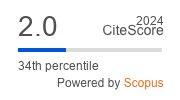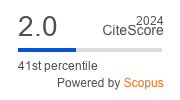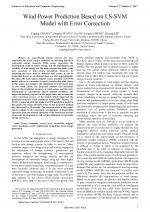| 1/2017 - 1 | View TOC | « Previous Article | Next Article » |
Wind Power Prediction Based on LS-SVM Model with Error CorrectionZHANG, Y. |
| Extra paper information in |
| Click to see author's profile in |
| Download PDF |
Author keywords
computer errors, error correction, support vector machines, power engineering computing, wind energy generation
References keywords
wind(19), energy(15), prediction(11), speed(10), power(7), renewable(6), jrenene(6), term(5), short(5), forecasting(5)
Blue keywords are present in both the references section and the paper title.
About this article
Date of Publication: 2017-02-28
Volume 17, Issue 1, Year 2017, On page(s): 3 - 8
ISSN: 1582-7445, e-ISSN: 1844-7600
Digital Object Identifier: 10.4316/AECE.2017.01001
Web of Science Accession Number: 000396335900001
SCOPUS ID: 85014266751
Abstract
As conventional energy sources are non-renewable, the world's major countries are investing heavily in renewable energy research. Wind power represents the development trend of future energy, but the intermittent and volatility of wind energy are the main reasons that leads to the poor accuracy of wind power prediction. However, by analyzing the error level at different time points, it can be found that the errors of adjacent time are often approximately the same, the least square support vector machine (LS-SVM) model with error correction is used to predict the wind power in this paper. According to the simulation of wind power data of two wind farms, the proposed method can effectively improve the prediction accuracy of wind power, and the error distribution is concentrated almost without deviation. The improved method proposed in this paper takes into account the error correction process of the model, which improved the prediction accuracy of the traditional model (RBF, Elman, LS-SVM). Compared with the single LS-SVM prediction model in this paper, the mean absolute error of the proposed method had decreased by 52 percent. The research work in this paper will be helpful to the reasonable arrangement of dispatching operation plan, the normal operation of the wind farm and the large-scale development as well as fully utilization of renewable energy resources. |
| References | | | Cited By «-- Click to see who has cited this paper |
| [1] A. Y. Sultan, C. Yassine, A. B. Abdullah, G. Adel, "Nested ensemble NWP approach for wind energy assessment," Renewable Energy, Vol. 37, pp. 150-160, Jan. 2012. [CrossRef] [SCOPUS Times Cited 53] [2] V. Prema, K. U. Rao, "Development of statistical time series models for solar power prediction," Renewable Energy, Vol. 83, pp. 100-109, Nov. 2015. [CrossRef] [SCOPUS Times Cited 126] [3] H. R. Zhao, S. Guo, "An optimized gray modal for annual power load forecasting," Energy, Vol. 107, pp. 272-286, Jul. 2016. [CrossRef] [SCOPUS Times Cited 198] [4] C. D. Zuluaga, M. A. Alvarez, E. Giraldo, "Short-term wind speed prediction based on robust Kalman filtering: An experimental comparison," Applied Energy, Vol. 156, pp. 321-330, Oct. 2015. [CrossRef] [SCOPUS Times Cited 159] [5] H. P. Liu, E. Erdem, J. Shi, "Comprehensive evaluation of ARMA-GARCH (-M) approaches for modeling the mean and volatility of wind speed," Applied Energy, Vol. 88, pp. 724-732, Mar. 2011. [CrossRef] [SCOPUS Times Cited 193] [6] C. Fan, S. Liu, "Wind Speed Forecasting Method: Gray Related Weighted Combination with Revised Parameter," Energy Procedia, Vol. 5, pp. 550-554, Apr. 2011. [CrossRef] [SCOPUS Times Cited 10] [7] P. Ramasamy, S. S. Chandel, A. K. Yadav, "Wind speed prediction in the mountainous region of India using an artificial neural network model," Renewable Energy, Vol. 80, pp. 338-347, Aug. 2015. [CrossRef] [SCOPUS Times Cited 151] [8] H. Chitsaz, N. Amjady, H. Zareipour, "Wind power forecast using wavelet neural network trained by improved Clonal selection algorithm," Energy Conversion and Management, Vol. 89, pp. 588-598, Jan. 2015. [CrossRef] [SCOPUS Times Cited 236] [9] M. A. Mohandes, T. O. Halawani, S. Rehman, A. A. Hussain, "Support vector machines for wind speed prediction," Renewable Energy, Vol. 29, no. 6, pp. 939-947, May. 2004. [CrossRef] [SCOPUS Times Cited 707] [10] K. G. Sheela, S. N. Deepa, "Neural network based hybrid computing model for wind speed prediction," Neurocomputing, Vol. 122, pp. 425-429, Dec. 2013. [CrossRef] [SCOPUS Times Cited 89] [11] K. Chen, J. Yu, "Short-term wind speed prediction using an unscented Kalman filter based state-space support vector regression approach," Applied Energy, Vol. 113, pp. 690-705, Jan. 2014. [CrossRef] [SCOPUS Times Cited 290] [12] Y. G. Zhang, J. Y. Yang, K. C. Wang, Z. P. Wang, Y. D. Wang, "Improved wind prediction based on the Lorenz system." Renewable Energy, Vol. 81, pp. 219-226, Sep. 2015. [CrossRef] [SCOPUS Times Cited 23] [13] Y. G. Zhang, J. Y. Yang, K. C. Wang, Y. D. Wang. "Lorenz Wind Disturbance Model Based on Grey Generated Components." Energies, Vol. 7, no. 11, pp. 7178-7193, Nov. 2014. [CrossRef] [SCOPUS Times Cited 14] [14] Y. G. Zhang, J. Y. Yang, K. C. Wang, Z. P. Wang, "Wind Power Prediction Considering Nonlinear Atmospheric Disturbances." Energies, Vol. 8, pp. 475-489, Jan. 2015. [CrossRef] [SCOPUS Times Cited 22] [15] Z.Y. Su, J.Z. Wang, H.Y. Lu, G. Zhao, "A new hybrid model optimized by an intelligent optimization algorithm for wind speed forecasting," Energy Conversion and Management, Vol. 85, pp. 443-452, Sep. 2014. [CrossRef] [SCOPUS Times Cited 98] [16] M. Monfared, H. Rastegar, H. M. Kojabadi, "A new strategy for wind speed forecasting using artificial intelligent methods," Renewable Energy, Vol. 34, no.3, pp. 845-848, Mar. 2008. [CrossRef] [SCOPUS Times Cited 231] [17] C. Ren, N. An, J. Z. Wang, et al., "Optimal parameters selection for BP neural network based on particle swarm optimization: A case study of wind speed forecasting," Knowledge-Based Systems, Vol. 56, pp. 226-239, Jan. 2014. [CrossRef] [SCOPUS Times Cited 529] [18] S. B. Ghosn, F. Drouby, H. M. Harmanani, "A Parallel Genetic Algorithm for the Open-Shop Scheduling Problem Using Deterministic and Random Moves," International Journal of Artificial Intelligence, Vol. 14, no. 1, pp. 130-144, 2016. [19] A. Mellit, A. M. Pavan, M. Benghanem, "Least squares support vector machine for short-term prediction of meteorological time series," Theor Appl Climatol, Vol. 111, pp. 297-307, May. 2013. [CrossRef] [SCOPUS Times Cited 139] [20] X. H. Yuan, C. Chen, Y. B. Yuan, Y. H. Huang, "Short-term wind power prediction based on LSSVM-GSA modal," Energy Conversion and Management, Vol. 101, pp. 393-401, Sep. 2015. [CrossRef] [SCOPUS Times Cited 256] [21] M. A. Ramírez-Ortegón, V. Märgner, E. Cuevas, R. Rojas, "An optimization for binarization methods by removing binary artifacts," Pattern Recognition Letters, Vol. 34, pp. 1299-1306,Aug. 2013. [CrossRef] [SCOPUS Times Cited 25] [22] R. E. Precup, S. Preitl, "Optimization criteria in development of fuzzy controllers with dynamics," Engineering Applications of Artificial Intelligence, Vol. 17, pp. 661-674, Aug. 2004. [CrossRef] [SCOPUS Times Cited 87] [23] Z. Li, L. Ye, Y. N. Zhao, X. R. Song, et al., "Short-term wind power prediction based on extreme learning machine with error correction," Protection and Control of Modern Power Systems, Vol. 1, pp. 2-8, Jun. 2016. [CrossRef] [24] E. A. Bossanyi, "Wind Turbine Control for Load Reduction," Wind Energ, Vol. 6, pp. 229-244, Jun. 2003. [CrossRef] [SCOPUS Times Cited 446] Web of Science® Citations for all references: 0 SCOPUS® Citations for all references: 4,082 TCR Web of Science® Average Citations per reference: 0 SCOPUS® Average Citations per reference: 163 ACR TCR = Total Citations for References / ACR = Average Citations per Reference We introduced in 2010 - for the first time in scientific publishing, the term "References Weight", as a quantitative indication of the quality ... Read more Citations for references updated on 2025-07-01 06:56 in 153 seconds. Note1: Web of Science® is a registered trademark of Clarivate Analytics. Note2: SCOPUS® is a registered trademark of Elsevier B.V. Disclaimer: All queries to the respective databases were made by using the DOI record of every reference (where available). Due to technical problems beyond our control, the information is not always accurate. Please use the CrossRef link to visit the respective publisher site. |
Faculty of Electrical Engineering and Computer Science
Stefan cel Mare University of Suceava, Romania
All rights reserved: Advances in Electrical and Computer Engineering is a registered trademark of the Stefan cel Mare University of Suceava. No part of this publication may be reproduced, stored in a retrieval system, photocopied, recorded or archived, without the written permission from the Editor. When authors submit their papers for publication, they agree that the copyright for their article be transferred to the Faculty of Electrical Engineering and Computer Science, Stefan cel Mare University of Suceava, Romania, if and only if the articles are accepted for publication. The copyright covers the exclusive rights to reproduce and distribute the article, including reprints and translations.
Permission for other use: The copyright owner's consent does not extend to copying for general distribution, for promotion, for creating new works, or for resale. Specific written permission must be obtained from the Editor for such copying. Direct linking to files hosted on this website is strictly prohibited.
Disclaimer: Whilst every effort is made by the publishers and editorial board to see that no inaccurate or misleading data, opinions or statements appear in this journal, they wish to make it clear that all information and opinions formulated in the articles, as well as linguistic accuracy, are the sole responsibility of the author.



